1676 John Speed Antique Map of County of Midlesex Views London & Westminster

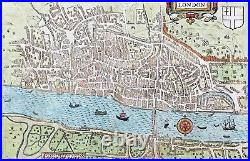
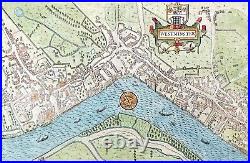
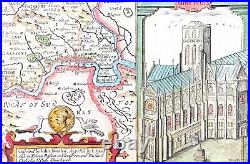

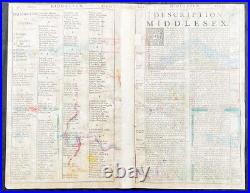
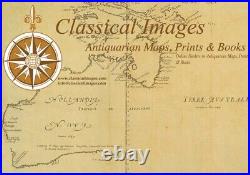

Midle-sex Described with the most Famous Cities of London and Westminster. Speed, John 1551 - 1629. 20 1/4in x 16 3/4in (515mm x 425mm).
This original hand coloured copper plate engraved antique map & views of London and the English county of Middlesex by John Speed was published in the 1676 Bassett & Chiswell edition of Speeds famous atlas The Theatre of the Empire of Great Britaine. The map is embellished with the famous birds-eye views of London, Westminster and the churches of St Peters (Westminster Abbey) and old St Pauls before the great fire of London in 1666. English descriptive text of London on the verso. Paper thickness and quality: - Heavy and stable Paper color : - off white Age of map color: - Original Colors used: - Yellow, green, blue, pink General color appearance: - Authentic Paper size: - 20 1/4in x 16 3/4in (515mm x 425mm) Plate size: - 20 1/4in x 16 3/4in (515mm x 425mm) Margins: - Min 1/8in (2mm). Margins: - L&R margins cropped to plate-marks Plate area: - Re-enforced along centerfold very small loss in places, light creasing Verso: - Re-enforced along centerfold and in several places with transparent archival tape. Background: This county map of Middlesex, now greater London, illustrates the market towns of Enfield, Pancras, Osterley and Staines. The map is dominated by four large vignettes with the environs of London and the county situated in the central portion of the map. The actual cartography is based on the surveys performed by John Norden, the earlier English antiquary and map maker, who unsuccessfully attempted to publish an updated county atlas of the United Kingdom before Speed. Norden also lived most of his life in Middlesex, thus becoming an obvious source for the map. The City of London is clearly shown on the lower right of the map with villages such as Hamsted, Pancras, Kensington and Paddington marked around the city. To the lower centre of the map is an acknowledgement to the original survey by Norden, augmented by Speed himself. Although the cartography is of some note, it is the vignettes for which this map is justly famous. To the two bottom corners are the famous Churchs of St. Peter (Westminster Abbey) Westminster on the left and St.This is the medieval Cathedral of St. Pauls, just after it had lost its spire in 1561 and before the Great Fire of 1666, in which it was destroyed then rebuilt in its present form by Sir Christopher Wren.
Above these two church vignettes are two text panels in the form of books, the one on the left describing the two churches and the other on the right with a description of London itself. Finally, two large vignettes on the upper left and right corners depict the two cities of Westminster and London respectively.
It is believed that Speed was not responsible for either of these images, more likely drawing from Norden, although there are no surviving evidence of this, to date yet to be found. There are also theories that these two views may have come from either a German sources or other lost birds-eye views of London by unknown persons. Due to modern growth of London and border changes, the county of Middlesex no longer exists, but there is little doubt this is the most the best map of London and Middlesex published in the 17th century. Speed, John 1551 - 1629 Speed was an English cartographer and historian.He is, alongside Christopher Saxton, one of the best known English mapmakers of the early modern period. Speed was born at Farndon, Cheshire and went into the tailoring business of his father, Samuel, later in life.
While working in London, Speed was a tailor and member of a corresponding guild, and came to the attention of learned individuals. These individuals included Sir Fulke Greville, who subsequently made him an allowance to enable him to devote his whole attention to research.
By 1598 he had enough patronage to leave his manual labour job and engage in full-time scholarship. As a reward for his earlier efforts, Queen Elizabeth granted Speed the use of a room in the Custom House.Speed, was, by this point, as tailor turned scholar who had a highly developed pictorial sense. In 1575, Speed married a woman named Susanna Draper in London, later having children with her. These children definitely included a son named John Speed, later a learned man with a doctorate, and an unknown number of others, since chroniclers and historians cannot agree on how many children they raised.
Regardless, there is no doubt that the Speed family was relatively well-off. At age 77 or 78, in August 1629, Speed died. He was buried alongside his wife in Londons St Giles-without-Cripplegate church on Fore Street. Later on, a memorial to John Speed was also erected behind the altar of the church. The website also notes that [t]he cast for the niche in which the bust is placed was provided by the Merchant Taylors Company, of which John Speed was a member. His memorial brass has ended up on display in the Burrell Collection near Glasgow. Speed drew historical maps in 1601 and 1627 depicting the invasion of England and Ireland, depictions of the English Middle Ages, along with those depicting the current time, with rough originals but appealing, colourful final versions of his maps. It was with the encouragement of William Camden that Speed began his Historie of Great Britaine, which was published in 1611. Although he probably had access to historical sources that are now lost to us (he certainly used the work of Saxton and Norden), his work as a historian is now considered secondary in importance to his map-making, of which his most important contribution is probably his town plans, many of which provide the first visual record of the British towns they depict. In the years leading up to this point, while his atlas was being compiled, he sent letters to Robert Cotton, part of the British government to ask for assistance in gathering necessary materials. His atlas The Theatre of the Empire of Great Britaine was published in 1611 and 1612, and contained the first set of individual county maps of England and Wales besides maps of Ireland and a general map of Scotland. [with] help of the tables... Any Citie, Towne, Borough, Hamlet, or Place of Note... With maps as proof impressions and printed from copper plates, detail was engraved in reverse with writing having to be put on the map the correct way, while speed copied, adapted and compiled the work of others, not doing much of the survey work on his own, which he acknowledged. The atlas was not above projections of his political opinions Speed represented King James I as one who unified the Kingdoms of the British isles.In 2016, the British Library published a book, introduced by former MP Nigel Nicolson and accompanied by commentaries by late medieval and early modern historian Alasdair Hawkyard, which reprinted this collection of maps on the British Isles, showing that Speed had drawn maps of areas ranging from Bedfordshire to Norfolk and Wales. Most, but not all, of the county maps have town plans on them; those showing a Scale of Passes being the places he had mapped himself.
In 1627, two years before his death, Speed published Prospect of the Most Famous Parts of the World which was the first world atlas produced by an Englishman, costing 40 shillings, meaning that its circulation was limited to richer customers and libraries, where many survive to this day. Much of the engraving was done in Amsterdam at the workshop of a Flemish man named Jodocus Hondius, with whom he collaborated with from 1598 until 1612, with Hondiuss sudden death, a time period of 14 years.
His maps of English and Welsh counties, often bordered with costumed figures ranging from nobility to country folk, are often found framed in homes throughout the United Kingdom. In 1611, he also published The genealogies recorded in the Sacred Scriptures according to euery family and tribe with the line of Our Sauior Jesus Christ obserued from Adam to the Blessed Virgin Mary, a biblical genealogy, reprinted several times during the 17th century. He also drew maps of the Channel Islands, Poland, and the Americas, the latter published only a few years before his death. On the year of his death, yet another collection of maps of Great Britain he had drawn the year before were published. Described as a Protestant historian, Puritan historian or Protestant propagandist by some, Speed wrote about William Shakespeare, whom he called a Superlative Monster because of certain plays, Roman conquest, history of Chester, and explored early modern concepts of national identity. As these writings indicate, he possibly saw Wales as English and not an independent entity. More concretely, there is evidence that Speed, in his chronicling of history, uses theatrical metaphors and his developed historiographic skill to work while he repeats myths from medieval times as part of his story. Since his maps were used in many high circles, Speeds legacy has been long-reaching.After his death, in 1673 and 1676, some of his other maps on the British isles, the Chesapeake Bay region, specifically of Virginia and Maryland, the East Indies, the Russian Empire then ruled by Peter the Great, Jamaica, and Barbados, among other locations. With these printings and others, Speeds maps became the basis for world maps until at least the mid-eighteenth century, with his maps reprinted many times, and served as a major contribution to British topography for years to come. In later years, Speed would be called our English Mercator, a person of extraordinary industry and attainments in the study of antiques, an honest and impartial historian, a faithful Chronologer, and our Cheshire historian... A distinguished writer on history. He was also called a celebrated chronologer and histographer, cartographer, and much more.
Even today, prints of his beautiful maps can be found in living rooms across the world, and sell for hundreds of thousands of pounds in rare art and map auctions, drawing in map collectors across the globe. Additionally, some use John Speeds maps, and connected commentary, to interpret William Shakespeares plays; however, Speed did not like Shakespeare in the slightest, and called him a papist.What is an Antique Map. The word Antique in the traditional sense refers to an item that is more than a hundred years old.
The majority of antique maps for sale today come from books or atlases and have survived due to the protection offered by the hardback covers. The first thing to determine when staring a collection or purchasing an item, is what is important to you. Most collectors prefer to build their collections around a theme.
You may decide to collect maps from one region or country, charting its development through time. Similarly you could collect maps of one particular period in time, by type i.
Sea or celestial charts or by cartographer. The collector might also want to consider the theme of cartographical misconceptions such as California as an island or Australia as Terra Australis or the Great Southern Land. The subject is so wide that any would-be-collector has almost endless possibilities to find his own little niche within the field, and thereby build a rewarding collection. Starting a collection & pricing. Pricing is based on a number of different factors, the most important of which is regional.In any series of maps the most valuable are usually the World Map and the America/North America. The World because it is usually the most decorative and America because it has the strongest regional market. Other factors that come into play re: price is rarity, age, size, historical importance, decorative value (colour) and overall condition and quality of paper it is printed on. As specialised dealers, we frequently work with first time map buyers who are just starting their collection. Classical Images was founded 1998 and has built an excellent reputation for supplying high quality original antiquarian maps, historical atlases, antique books and prints.
We carry an extensive inventory of antiquarian collectibles from the 15th to 19th century. Our collection typically includes rare books and decorative antique maps and prints by renowned cartographers, authors and engravers. Specific items not listed may be sourced on request. Classical Images adheres to the Codes of Ethics outlined by the Antiquarian Booksellers Association of America (ABAA). We are a primarily an online based enterprise, however our inventory may be viewed by appointment.